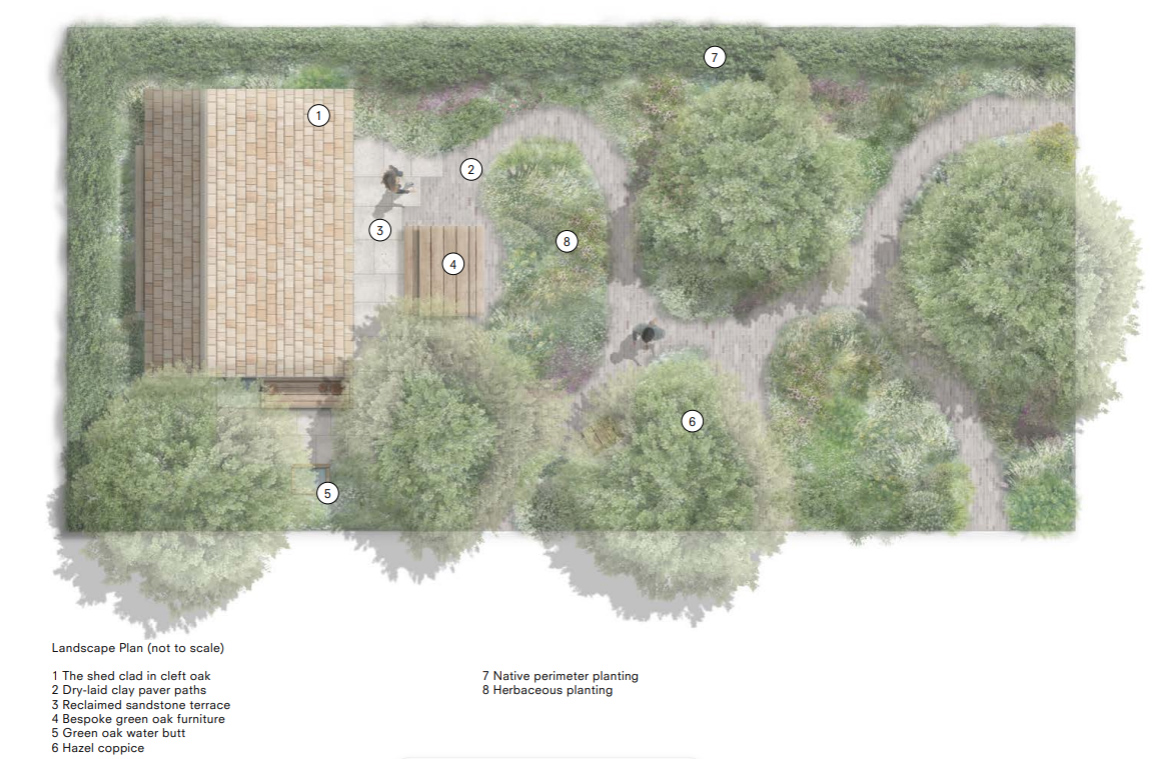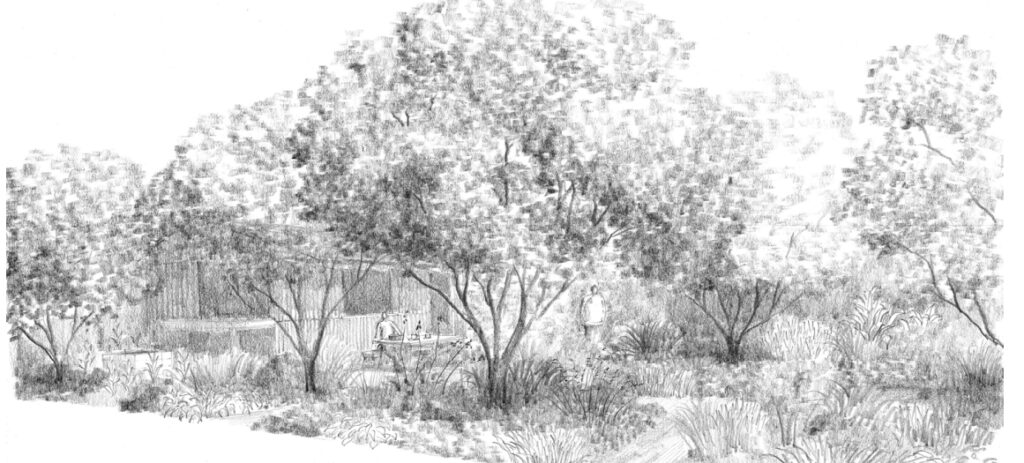The Garden Proposal by Tom Stuart-Smith

The National Garden Scheme has established for nearly 100 years a uniquely creative way of raising funds for charity by giving people affordable access to the finest gardens in the country. It has been around for such a long time that some people take it for granted and yet a lot of people don’t know about it at all. I have opened my garden at my home in Hertfordshire for the National Garden Scheme for more than 25 years and every year, as I watch several hundred people sitting on the lawn drinking tea and eating cake I marvel with gratitude to the National Garden Scheme for having fostered this uniquely civilised, British tradition. Our garden for Chelsea will celebrate this and bring it to a much wider audience.
The garden proposed for Project Giving Back at Chelsea is designed as a small community garden with a volunteer’s mess room. We have chosen this as a model for the show so as to reflect the increasing involvement of the National Garden Scheme in supporting community and therapeutic gardens. We also want to celebrate the knowledge of National Garden Scheme owners and the generosity with which they share their gardens with visitors, and this will be showcased in in a central feature of the garden. This will be a plant collection, some of which will be donated by National Garden Scheme garden owners, laid out through an open hazel coppice. While there will be quite a number of interesting specimen plants there will also be a certain amount of repetition to give some overall continuity and coherence to the planting. This central area will be framed by other less structured planting containing a mix of exotic and native varieties and incorporating a mixture of wildlife friendly features such as nesting sites. At the back of the garden is a gardener’s shed which doubles up as a meeting place for garden volunteers and a place for serving home-made teas, that quintessential element of an National Garden Scheme garden open day.
From the showground, the garden’s legacy and future life will be secured by moving it to Maggie’s Cambridge where the garden will also be designed by Tom Stuart-Smith. Maggie’s has for many years placed gardens as a central part of their philosophy of creating a therapeutic environment in which support can be provided for people with cancer. The National Garden Scheme has already been a significant funder of gardens for Maggie’s centres and has recently committed to a ten-year programme of support, so it is very appropriate that the garden could have an afterlife that reflects its original character and meaning at Chelsea. Maggie’s Cambridge will be located on the edge of an old oak woodland on heavy clay on the south side of the city. This has prompted the use of cleft oak as the cladding material for the garden shed and the use of hazel as the main species for the garden so that the materiality and planting in the garden is very much influenced by the place.
Because Maggie’s is still in an early stage of planning it will not be appropriate to keep the herbaceous plants for the garden. So, Crocus in collaboration with the National Garden Scheme will organise and publicise a sale of the plants which will take place at Chilworth Manor in Surrey on 1 June, following RHS Chelsea. We see this as a further opportunity to raise awareness of the National Garden Scheme and raise significant funds for the charity.
The proposed shed
This is a carbon sink building constructed of Cross Laminated Timber (CLT) timber and insulated with Hempcrete. Clad with cleft oak and roofed with timber shingles, the building will be an exemplar of sustainable construction. The interior will be entirely made from locally sourced timber. The shed would be a place where a small team of gardeners and volunteers can get out of the weather, serve some tea to volunteers and even have a slice of the quintessential National Garden Scheme cake.
The terrace and paths
We envisage the principal path surfaces being made of reclaimed York stone. We propose to make garden furniture, potting benches and a water butt out of locally sourced green oak. These will have a slightly rough and robust character but we think this is appropriate for its use.
The planting
The garden will be enclosed on the back side and the boundary side by dense hedging, based on native species and foraging plants so amongst the hawthorn and holly would be raspberries, blackcurrants blackberries, crab apples and cornelian cherries. The perimeter planting will include native species such as foxglove, woodruff, Bugle, Wood Mellick, various native sedges and cow parsley. The central plant collection will be laid out through an open grove of large hazel bushes. These would be about 4-5m high and similarly wide. This will give the garden a unified scale and a gentle, green calm. The planting of the herbaceous layer will simulate the planting of a hazel coppice but using a wide range of ornamental plants and concentrating on plants generally tolerant of the drier conditions prevalent in Cambridge. It is a garden looked after by volunteers, so isolated watering of plants is possible and this makes it appropriate to include some woodland genera which might otherwise not cope with a dry East Anglian summer.
In the shade of the hazels this would include woodland genera such as Kirengeshoma, Smilacina, Carex, some Paeonia species, different Actaea varieties (mainly for foliage – but including spring flowering species), Astrantias, Rodgersia pinnata alba, Gillenias, Thalictrums, Euphorbias, Geraniums and Epimediums. In the sunny parts of the garden the planting would include a range of Iris sibiricas, Amsonias, Anthericum, single peonies, Thalictrums and grasses. There will be some biennial species such as Hesperis, Digitalis and Orlya that will be allowed to seed though the other planting.
The atmosphere will be that of a gentle woodland glade. A therapeutic place to spend time in.



















